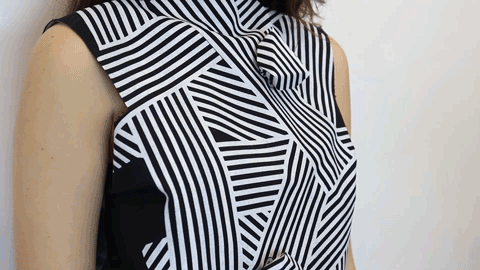
‘Levende’ robot-sieraden reageren op ons lichaam en lichaamsbewegingen.
Locatie: Bibliotheek Eindhoven (video)
Exploring a dynamic future in which the accessories we wear are no longer static, but are instead mobile, living objects on the body. Engineered with the functionality of miniaturized robotics, this “living” jewelry roams on unmodified clothing, changing location and reconfiguring appearance according to social context and enabling multiple presentations of self. With the addition of sensor devices, they can actively respond to environmental conditions. They can also be paired with existing mobile devices to become personalized on-body assistants to help complete tasks. Attached to garments, they generate shape-changing clothing and kinetic pattern designs—creating a new, dynamic fashion.
It is our vision that in the future, these robots will be miniaturized to the extent that they can be seamlessly integrated into existing practices of body ornamentation. With the addition of kinetic capabilities, traditionally static jewelry and accessories will start displaying life-like qualities, learning, shifting, and reconfiguring to the needs and preferences of the wearer, also assisting in fluid presentations of self. With wearables that possess hybrid qualities of the living and the crafted, we explore a new on-body ecology for human-wearable symbiosis.
https://www.media.mit.edu/projects/kino-kinetic-wearable/overview/
CREDITS:
Cindy Hsin-Liu Kao, MIT Media Lab
Deborah Ajilo, MIT Mechanical Engineering
Oksana Anilionyte, Royal College of Art
Artem Dementyev, MIT Media Lab
Inrak Choi, Stanford Mechanical Engineering
Sean Follmer, Stanford Mechanical Engineering
Chris Schmandt, MIT Media Lab
MIT Media Lab in collaboration with MIT Mechanical Engineering, Royal College of Art, and Stanford University’s Department of Mechanical Engineering
SPECIAL THANKS:
We thank undergraduate researchers Karla-Sofia Zapata-Garcia and Daphne Lin for help with prototyping, and Seth Avecilla for screen printing and garment construction support. This project was supported in part by the MIT Council of Arts Grant and the Bill Mitchell++ Fund.
Kino FAQ



 English
English